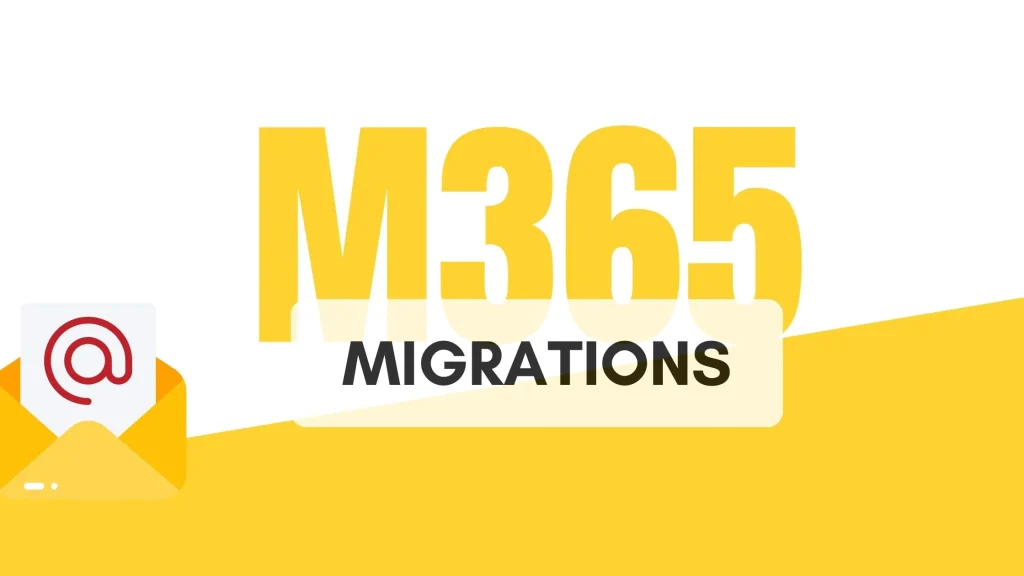Microsoft M365 Migrations – Meaning & Types

What is M365?
Ever heard of Microsoft 365 (M365)? It’s more than just the new name for Office 365. It’s a complete cloud-based productivity suite that’s revolutionizing the way people work, learn, and connect. Whether you’re a tech whiz or just starting out, M365 has something to offer everyone.
Think of M365 as your one-stop shop for all things productivity. It combines familiar Office applications like Word, Excel, PowerPoint, and Outlook with a host of other services, including:
- OneDrive: Cloud storage for your files and documents, accessible from anywhere.
- SharePoint: Online collaboration platform for teams to work together on documents, projects, and more.
- Teams: Chat, video conferencing, and file sharing are all in one place, making communication and collaboration seamless.
- Exchange Online: Business-grade email with powerful features like scheduling and calendar management.
Why M365 is widely popular
Microsoft 365 (M365) has taken the world by storm, becoming the go-to platform for individuals and businesses alike. Its popularity stems from its unique combination of accessibility, collaboration, security, scalability, and affordability.
Imagine working on a critical project with colleagues across the globe, all at the same time, while securely accessing and editing documents from any device, whether it’s your laptop, tablet, or even your phone. This is the reality M365 delivers. Real-life examples abound a small design team collaborating on a logo across continents, a global sales team sharing client information in real time, or a remote student attending online classes and completing assignments seamlessly.
With robust security features like multi-factor authentication and data encryption, M365 gives users peace of mind knowing their data is safe. Additionally, its scalability allows businesses to easily add or remove users as their needs change, making it adaptable to both small startups and large corporations. Perhaps the most appealing aspect – M365 offers various subscription plans to fit any budget, making it an accessible and cost-effective solution for everyone. From students to entrepreneurs to global enterprises, M365 empowers users to work smarter, collaborate seamlessly, and achieve more.
M365 Migrations – Meaning, Types
Embarking on the journey of transitioning your organization to Microsoft 365 (M365) or moving a work Mailbox involves thoughtful consideration of various migration types offered by the M365 migration service.
1. Mailbox Migrations
mailbox migration refers to the process of transferring email data, including messages, attachments, contacts, and calendar information, from an organization’s on-premises email servers to the M365 ecosystem. The migration team uses a wide range of tools to complete the migration.
Cutover Migration
For small organizations with limited downtime tolerance, the cutover migration method presents an ideal solution. This approach involves a one-time migration event where all mailboxes are moved to M365 simultaneously, minimizing disruption.
Staged Migration
In contrast, the staged migration method is suited for larger organizations or those with critical business functions. By migrating mailboxes in batches, this strategy ensures a controlled and gradual process, allowing for a more seamless transition.
IMAP Migration
For organizations already utilizing IMAP, the IMAP migration method facilitates the movement of mailboxes from on-premises IMAP servers to Microsoft Exchange Online, providing a smooth transition to M365.
Hybrid Migration
The hybrid migration method involves setting up an environment where on-premises Exchange servers coexist with Exchange Online. This allows for the gradual migration of mailboxes to M365 using the MRSProxy service, providing flexibility and control.
Cross-Tenant Mailbox Migration
This method enables organizations to move mailboxes between different M365 tenants. It is commonly employed during mergers or divestitures when the need arises to seamlessly transition user data across different environments.
2. Data Migrations
OneDrive Migration
To transfer data from on-premises OneDrive for Business to OneDrive for Business in M365, organizations can leverage the OneDrive migration method, ensuring a smooth and efficient transition of individual user data.
SharePoint Migration
The SharePoint migration method facilitates the movement of content from on-premises SharePoint sites to SharePoint Online in M365, streamlining the transition of collaborative and document-centric workspaces.
Teams Migration
For organizations using on-premises Microsoft Teams, the Teams migration method ensures the seamless transfer of data to Teams in M365, preserving collaboration history and ensuring continuity.
Tenant-to-Tenant Migrations
Tenant-to-tenant M365 migrations refer to the process of moving data, users, and configurations from one Microsoft 365 (M365) tenant to another. In the context of M365, a “tenant” refers to a dedicated and secure instance of the Microsoft cloud service that an organization subscribes to. Each tenant has its own user accounts, data storage, and configurations.
In events like Mergers, acquisitions & transitions Tenant-to-tenant Migrations become relevant.
Single-Event Migration Flow
This method involves migrating all users and data from one M365 tenant to another in a single step, simplifying the process for organizations undergoing significant structural changes.
Phased Migration Flow
Organizations seeking a more controlled and gradual transition can opt for the phased migration flow, which migrates users and data in batches, minimizing disruption and allowing for a smoother migration process.
Tenant Move or Split Flow
For scenarios where a single M365 tenant needs to be split into two separate tenants or two tenants need to be merged into one, the tenant move or split flow method provides the necessary flexibility to manage these structural changes seamlessly.
Choosing the Right Migration Type
Selecting the appropriate M365 migration service depends on your organization’s specific needs, size, and tolerance for downtime. Understanding the nuances of each migration type empowers decision-makers to choose the strategy that aligns with business objectives, ensuring a seamless transition to Microsoft 365.
M365 Migrations aren’t just for Corporations
M365 migration is not just for corporations. While it’s commonly used for businesses transferring their data and email to the cloud, it can also be beneficial for individuals in certain situations.
There are some scenarios where you might want to consider M365 migration
When Moving to a new email address
If you’re changing email addresses, you can use M365’s migration tools to transfer your old emails, contacts, and calendar data to your new account. This can be helpful if you’re switching jobs, retiring, or simply want a fresh start.
Consolidating multiple email accounts
Do you have multiple email accounts scattered across different providers? M365 can help you consolidate them into one central location, making it easier to manage your messages and contacts.
Backing up your data
You can leverage Microsoft M365 for backing up data. M365 offers secure cloud storage for your email, contacts, and calendar data. This can be a valuable backup solution, especially if you’re concerned about losing your data due to a computer crash or hardware failure.
Closing notes
Consider the diverse range of migration types available to tailor your approach to the unique needs of your organization. Whether it’s mailbox migrations, data transfers, or tenant-to-tenant transitions, each strategy plays a crucial role in achieving a successful and efficient migration to Microsoft 365.
Activelobby has dedicated teams for Email Migrations whether it’s simple Mailbox Migrations or M365 Tenant to Tenant migrations. If you have any questions or looking for help with M365 Migrations. Contact us today.
